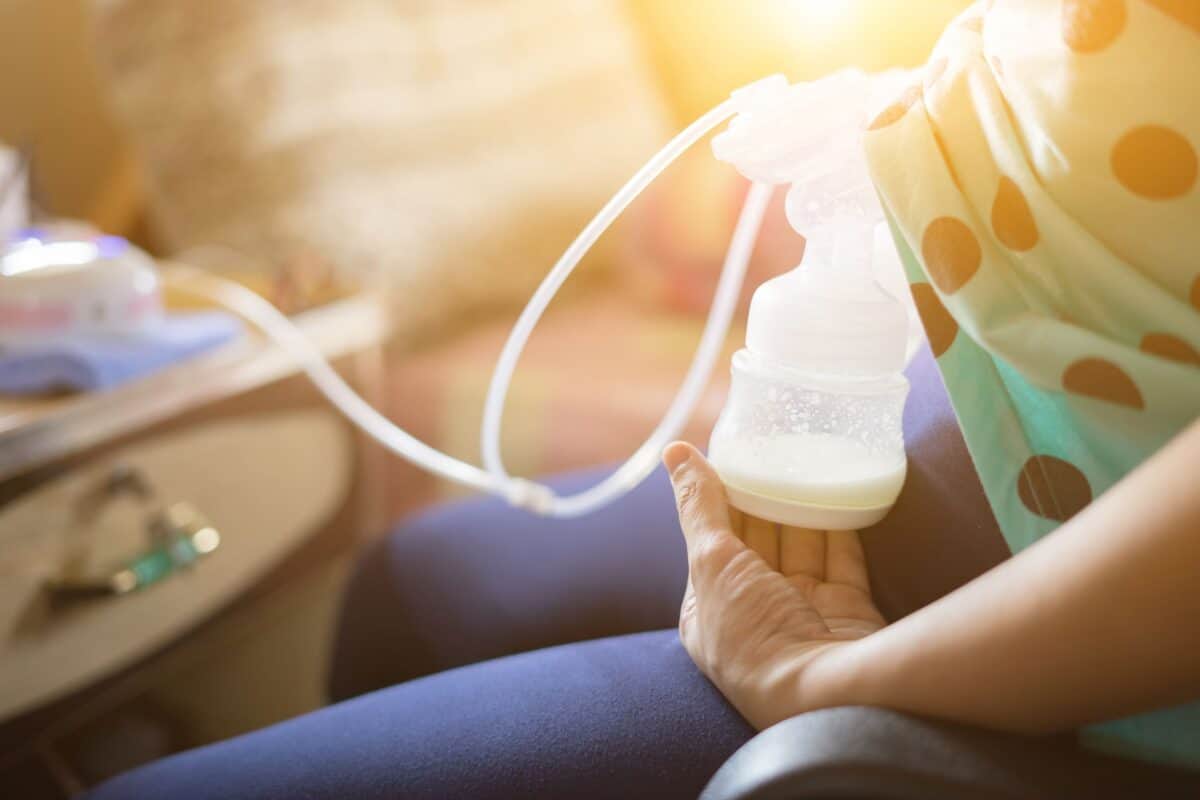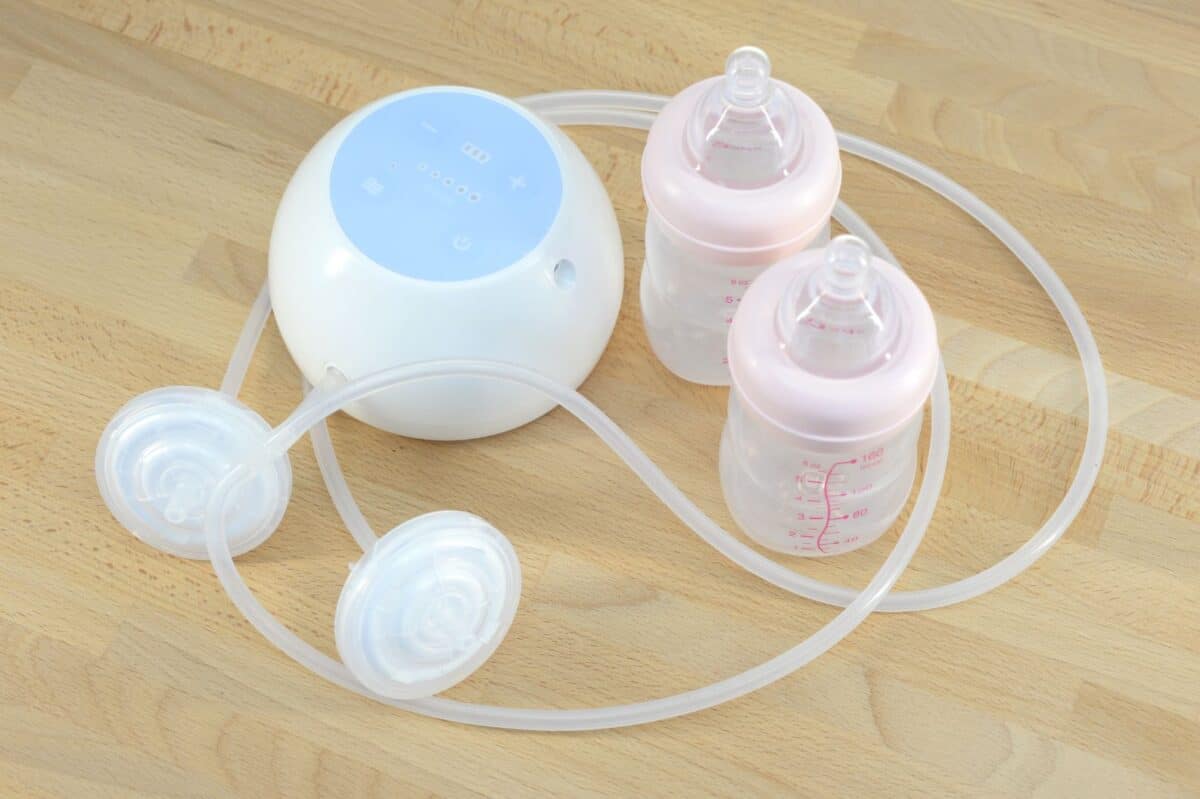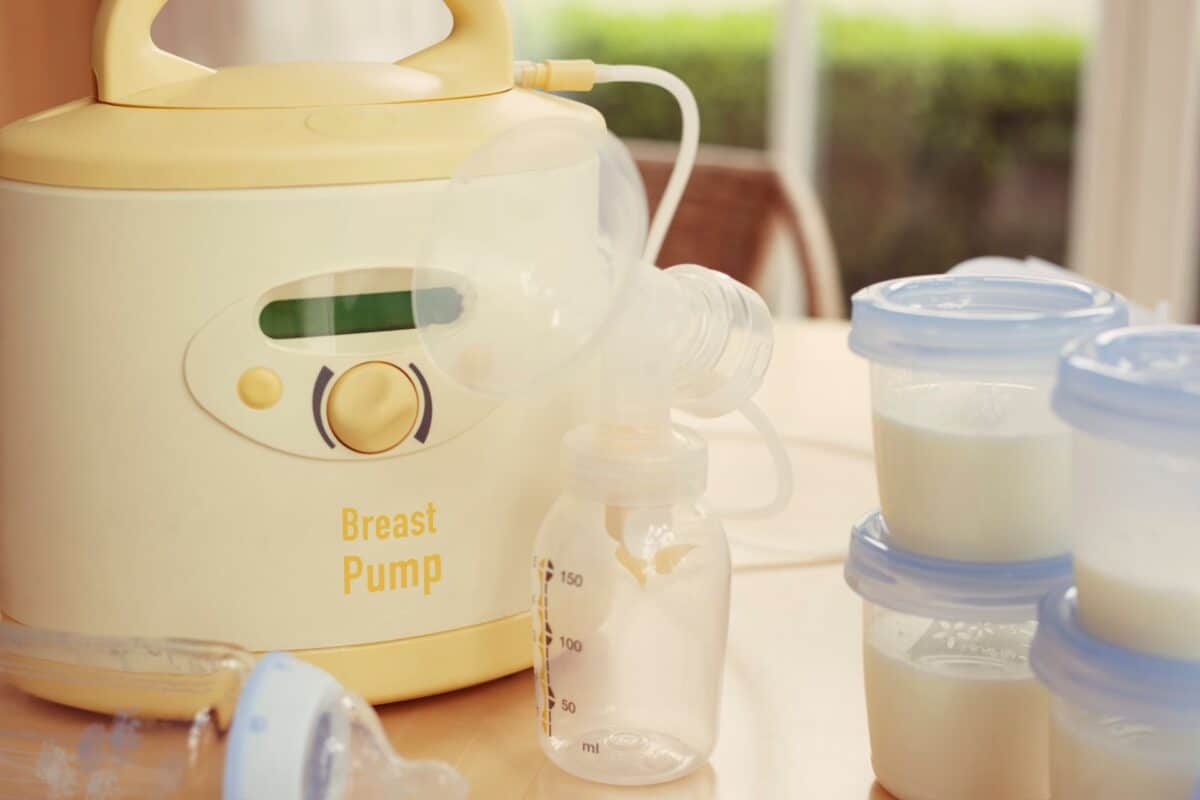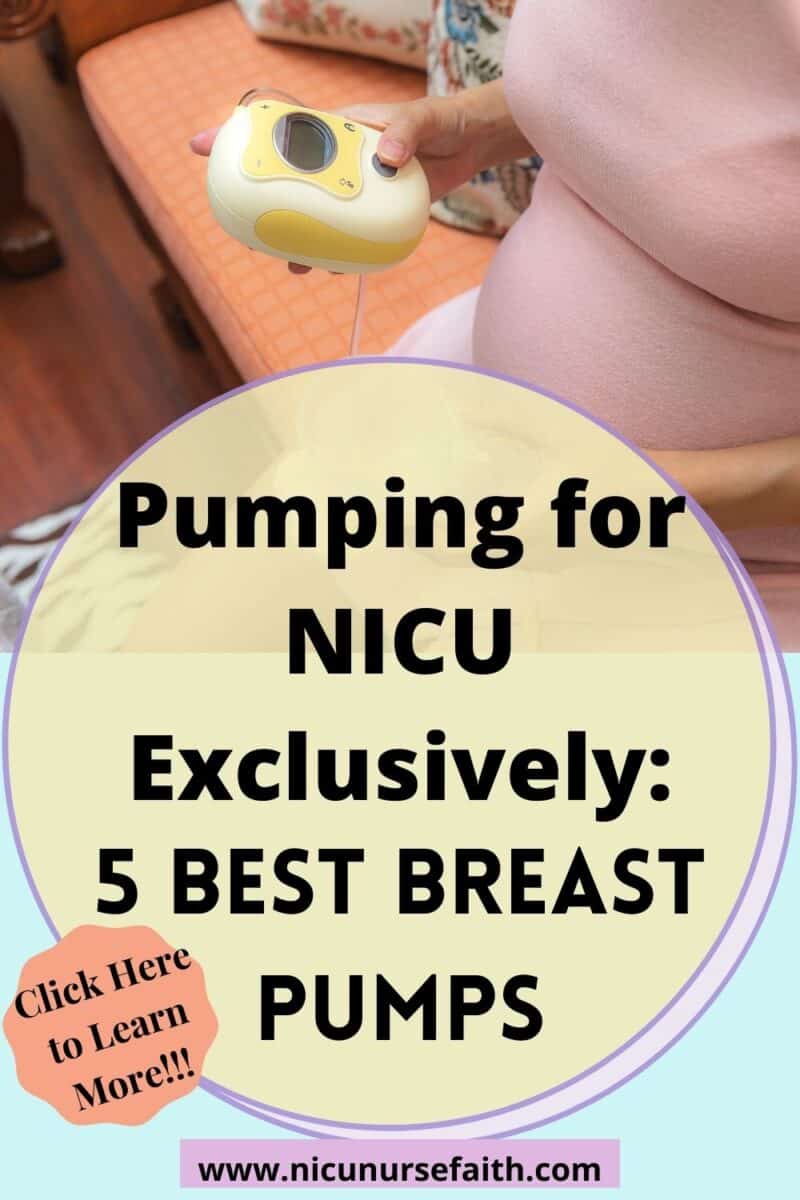Best Breast Pumps for Pumping for Your NICU Baby Exclusively
Looking to start or continue to pump for your preemie?
The key is to find the best breast pump that fits you and your needs.
Pumping for a preemie takes work and time.
But it’s worth it!!
Once you become a NICU mom, no one tells you exactly what pumping and breastfeeding will look like.
So, some moms lose hope of ever going to breastfeed their preemie because they think their baby won’t be able too.
But you WILL be able to breastfeed, if you put the work in with pumping, so don’t ever lose HOPE!
And as long as you have a great pump that you like, you can keep up your breast milk supply and eventually transition to breastfeeding, if that’s your goal.
Personally, finding a great pump is what helped me pump for a while before I switched to breastfeeding.
I eventually ended up switching to exclusively pumping because I decided that pumping was what was good for me and my baby.
In this post, I’m going to discuss why pumping initially is important to help start breastfeeding and also introduce 5 of the best pumps on the market to pump for preemies.
So let’s get started!

Please note that this article contains affiliate links. That means if you buy something, I earn a small commission, at no extra cost to you! I only recommend products I love! Read my disclosure for more details.
5 Breast Pump Recommendations for Preemies
These are the best five pumps I found in my research when I was looking for my own pump.
All these pumps either I have used or close family/friends have used it.
What I learned is that there isn’t one pump fits all.
It all depends on what you are looking for.
I have written down a description of each pump and included pros and cons for each pump too.
What works for me might not work for you, so these are just my recommendations.
Also, double check with your insurance company before purchasing a pump on your own.
Your insurance company might give you a free pump.
So lets get started!
Lansinoh:
I used the Lasinoh Signature Pro Double pump and I really liked it.
It has all the features I wanted and it’s simple to use.
It has great suction that wasn’t too strong.
It has a LCD screen with a night light and timer.
It has the 2 phase pumping; it goes automatically from massage to expression mode, so perfect for first-time moms.
It can be used for single sided pumping.
This pump doesn’t have the app to track your pumping sessions. I just did the tracking of my pump sessions and volumes the old way – in my notes app on my phone :).
The Lasinoh Smartpump 2.0 Electric Pump has the smart feature of the app.
This pump is the exact same as my pump and the only difference is the smart feature of the app.
The app is not a must, but if you want to spend some extra bucks, it’s very convenient and will save you the time to write all your pumping volumes down. It’s up to you. I have linked both pumps below.

PROS:
- Easy to control the level of suction intensity, can go from high to low suction with a couple of clicks
- different modes of suction
- flanges are very comfortable on your breast
CONS:
- There are lots of parts to wash
- It needs so many batteries (6 AA batteries) & the batteries don’t last that long when portable, so I have to change out the batteries or keep it plugged in to be used.
Spectra S1
This is a very popular pump.
Most moms on NICU social media groups rave about this pump and the comfort of it.
It has many options to customize and make it really gentle.
A couple of my friends have this pump and they really like it.
It can be used for single breast pumping.
It is charged with a charger.
It has 2 phase pumping, but it starts off in expression mode first, so you have to choose massage mode right away.
It has a night light and has a timer of how long you used it for.
It doesn’t connect to an app or have a smart feature.
I have linked the pump below

PROS:
- great for sensitive nipples with not too high of a suction
- gentle feels nice
- quiet with pumping (more like a hum)
CONS
- it’s very large in size, so it’s not best to leave the house with it
- can be confusing to use with many buttons
- the suction might not be strong enough to fully empty for some moms
Baby Buddha
It’s a small pump, but very strong!
Most moms say that the suction is much longer in pattern than other pumps and it needs time to get used too.
It can be used for single breast pumping.
It has a USB charger, so you can charge it in the car.
It has 2 phase pumping and you choose which phase you want to start with.
It doesn’t have an app or a smart feature.
It has a timer to show you how long you have been pumping.
The numbers are bright and can be used at night.
I have linked the pump below.

PROS
- small and rechargeable, no batteries needed
- buttons are very easy to use
- gentle suction, but the suction can be very strong and can empty really well
CONS
- if you have sensitive nipples, then the suction might be too strong.
- the most expensive pump on the list
- the battery life is not long- once charged, it lasts 1 hr.
Ameda Mya
This is a great pump for many moms.
The suction is great.
The portability and size are loved by many moms.
It can be used as a single side pump.
It has a LCD screen with a timer and a night light.
It has 2 phase pumping; massage and expression mode that you have to change back and forth when needed.
It doesn’t connect to an app or have a smart feature.
I have linked the pump below.

PROS
- small and has a rechargeable battery, so very portable
- great suction and gentle
- very quiet
CONS
- The only flange sizes that it comes with are 24 and 28, so if you are smaller you have to buy your own flange.
- Some moms noticed that the battery drains even when you are not using it.
BellaBaby
It’s the cheapest and it’s an amazing price, so most moms ignore the cons of the pump.
It has a USB charger, so you can charge it in your car.
It doesn’t have an app or a smart feature.
I have linked the pump below.

PROS
- amazing price, it’s the cheapest pump on the list
- small and very portable with a rechargeable battery pack
- can easily pump into a breast milk bag for storage
CONS
- it’s not user friendly in that you can’t go up and down levels easily. If you need to go down a level, you have to cycle through all the levels up (ouch!)
- it comes with only a 28 size flange, which is big for the average woman

Why do I have to Pump for my Preemie, and can’t Breastfeed?
The path to eating for a preemie is usually not a smooth ride.
Eating is a special and complicated skill all preemies have to learn, so establishing breastfeeding can take a while for some babies.
Before the baby can learn to eat, they have to learn how to breathe!
And it takes time for a premature baby to grow and learn how to breathe on their own.
That explains why breastfeeding or bottlefeeding is not started until later on.
Until then, you have to pump from the beginning and throughout your NICU Journey to keep your milk supply up.
So, you will have enough milk when you transition to breastfeeding your baby.
This is why pumping from the beginning is important for all NICU moms.

Explain the Journey from Pumping to Breastfeeding/Bottle Feeding
All NICU moms are always given a pumping kit in postpartum to start pumping ASAP.
Pumping right away will stimulate your breast and remind your body to produce milk for your baby.
There are specific actions you can take to establish a great milk supply.
Check out these amazing pumping tips for new NICU moms.
There are signals and steps we, as NICU nurses, monitor and take to get a baby from tube feeding pumped milk to breastfeeding/bottle feeding.
It’s a lot of information, so I’ll be doing a detailed post on this topic of feeding in the future, so stay tuned!
But right now, I’ll list the basic steps that are taken to transition from pumping to breastfeeding, so moms can understand the basics.
DISCLAIMER: Every hospital is different and has different practices. Talk with your medical team about their plans and steps to help transition to oral feeding by bottle or breast
⇨The key to feeding is that preemie babies have to learn SUCK, SWALLOW and BREATHE coordination!
⇨this is a learned skill that nurses and parents help to teach by introducing new stimuli ( ie. a soother, milk, bottle/breast) and watching for changes in oxygen, heart rate and breathing.
Basic Steps to transition to oral feeding:
- Baby has more awake periods and signalling that he/she wants the soother (ie. sucking on their hands, opening their mouth up)
- Offer soother and monitor for desaturation (low oxygen AKA desat) or bradycardia (drop in heart rate AKA brady). Baby is learning the suck, swallow and breathe method → do this for a couple of days
- Then start introducing drops of milk on the corner of the soother, monitor for desats and bradys →do this for a couple of days
- If the baby is tolerating drops, then introduce a bottle with a specific volume and a limited time they have to take the bottle. Also, introduce a pumped breast with a time limit on breastfeeding. After the time limit is done, we give the rest of the feed via NG tube.
- As the baby gets stronger and builds endurance, you increase the bottle volume or continue to feed on a pumped breast, then you subtract the volume taken by mouth from the amount given in NG.
- This above step takes time because the baby has to be comfortable with feeding by a bottle or breast well to subtract the amount from the NG tube feed.
- We want to avoid “negative feeding experiences” like many desats and bradys with feeding → if this happens we stop the oral feeding (either bottle or breast) and just give the rest of the feed through NG.
- Eventually, your baby will be able to bottle feed or breastfeed on a full breast and not need to “top up” with NG.
Tips to remember:
- Micro preemies (born less than 28 wks) take a longer time to learn the skill of suck, swallow and breathe, so we need to be careful and take our time teaching this so we don’t make feeding a bad experience
- We always offer a bottle or breast, not both because this will tire the baby out!! Then we give the rest of the feed through the NG tube. So either bottle+NG or breast+NG.
- Only give oral feeds (ie. breast or bottle) when the baby is awake and when the baby is showing cues of wanting to eat by mouth (AKA opening the mouth, sucking hands).
- Don’t push your baby if they are not ready… go by their signals!
- Reflex can cause babies to have increased Brady’s, desats and be slower to eat. Stay tuned for a blog post on reflux and how to manage it!
- Consistency is key to successful feeding… create a feeding plan with your nurses on how everyone should feed your baby.
Common Questions about Pumping for Preemies in NICU

What is a hospital grade pump and do I need a hospital grade pump?
Hospital grade pumps are the big, bulky pumps that are meant for many users.
It’s heavy and it has a very strong motor that lasts for years.
Hospital grade pumps are very expensive to buy, so most moms just rent it.
And every hospital has a hospital grade pump.
**ALWAYS check with your insurance if they cover the fee of renting a hospital grade pump**
The most popular hospital grade pumps are the Medela Symphony and Ameda Elite Pump.
It’s very strong, so hospital grade pumps are mostly used at the beginning by many moms to establish milk supply.
Then after 4-6 wks, when your milk supply is increasing and better established, you can switch to one of the “personal” pumps I mentioned above
The breast pumps I mentioned above are more automatic individual pumps.
They are lightweight, couple users can use it and there is a lifespan on it.
How often should I pump for my preemie?
You should pump every 2-3 hrs from the beginning.
Around day 3-5, your milk will come in and you will feel engorged, so you can pump more often to find relief.
Otherwise, pumping every 2-3hrs will empty your breast and stimulate your body to make more milk.
Also, as a mom of a preemie, you might be pumping a lot more milk than your baby is currently eating.
Therefore, you can freeze the extra milk in a regular freezer or a deep freezer.
How do I increase my milk supply when my baby is in the NICU?
Having a dip in your milk supply while your baby is the NICU is common.
So don’t give up!
I’ll be making a blog post in the future with more details on this topic so stay tuned!
Until then, drinking lots of water and eating lots including snacking is important.
Also power pumping is amazing to remind your body that more milk is needed.
Also, try to decrease stress ( I know, I know… this is hard!).
Try to take a day off from the hospital visiting your little one and instead do self care activities like pedicure, manicure or anything that will relax you.
Try to not forget about your family and friends, and enjoy your life outside NICU too.
Final Thoughts on Pumping for Your Preemie
If you want to breastfeed your baby, you can!
If you want to bottle feed your baby, you can too!
Preemie babies will eventually learn how to eat by mouth.
If your baby goes home with a NG tube or a G tube, they will have many sessions with an OT (occupational therapist) to help with learning how to eat by mouth again and make it a pleasant experience.
The biggest takeaway here is to keep up your milk supply until your baby is ready to breastfeed or bottle feed.
So definitely invest in your own pump!
If you have any questions, feel free to contact me or send a message to @nicunursefaith on Instagram.
How was your pumping experience and the transition to breastfeeding or bottle-feeding?
COMMENT BELOW
If anything on my blog has helped you, please make sure to share the post, comment below the post and subscribe to my email list for more goodies.
I would love to hear from you!
Follow me on Instagram: @nicunursefaith
Related Articles on Pumping for your Preemie in NICU


